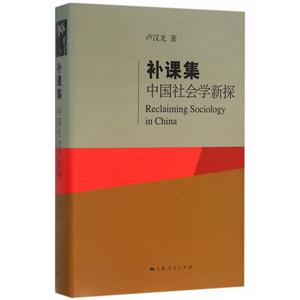補課集-中國社會學新探 版權信息
- ISBN:9787208135970
- 條形碼:9787208135970 ; 978-7-208-13597-0
- 裝幀:暫無
- 冊數:暫無
- 重量:暫無
- 所屬分類:>
補課集-中國社會學新探 本書特色
本書循著20世紀80年代中國恢復社會學教學和研究以來的軌跡,記錄和展示了該學科在理論補課和實踐發展中的足跡。全書多方位地提供了中國社會學新探索以來的成果:從社會學如何走出歷史陰影,確立起獨立社會科學學科地位開始,用社會學的視野對中國當代社會變遷提供了獨到的理論認識,同時通過一系列深入的社會調查來報告各種社會學議題的研究發現。作者特別關注草根社會從社區到社團的現代化發展進程,并提供了社會學研究如果應用于公共政策和社會治理,發揮思想智庫作用的經驗。
補課集-中國社會學新探 內容簡介
盧漢龍是中外很少見到的接合社會學研究與社會管理需求的學者。他做研究:謹慎思考理論背景和布局,仔細挑選主題,精心設計問卷和指標,同時運用質與量的田野方法,兼顧中外學術考量,緊扣當前社會政策和管理議題需要。三十多年來,鍥而不舍,埋頭耕耘。欣見《補課集》,讓學者、管理工作者和關心社會的讀者,分享其成,實為應用社會學的典范與楷模。
補課集-中國社會學新探 目錄
自序............................................................................................................1**篇.理論方法篇——社會學的“基”與“本”...............11.1 馬克思主義社會學和其他社會學.........................................21.2 社會學是研究社會整體的科學..............................................91.3 中國人調查中國社會的**次嘗試................................... 171.4 社會調查的科學性與程序性................................................ 201.5 調查問卷的意義界定............................................................ 241.6 論社會指標的基本問題........................................................ 321.7 論中國社會學的理論建設.................................................... 471.8 迎接中國社會學的春天........................................................ 56第二篇.基本認識篇——社會學視野看中國變遷................ 602.1 論城市居民社會地位的認同................................................ 612.2 單位制與住房商品化............................................................ 732.3 從“墻頭經濟”看中國產權文化....................................... 932.4 中國社會主義實踐的三大轉變.......................................... 1092.5 消費文化與消費革命.......................................................... 1362.6 關于社會結構理論的反思.................................................. 1522.7 人力資本與階層分化..........................................................1732.8 全面“小康”與中國“中產”............................................1812.9 轉型社會研究.......................................................................196第三篇.調研報告篇——來自社會的經驗研究..................2053.1 社會指標與生活質量研究..................................................2053.2 上海市民生活質量報告......................................................2373.3 角色壓力與精神健康..........................................................2733.4 上海解放前移民研究..........................................................2923.5 中年人的家庭與職業..........................................................3053.6 收入差距與社會不平等......................................................3303.7 就業市場和中國市場化轉變..............................................3353.8 企業的社會角色與捐贈行為..............................................350第四篇.草根社會篇——從“社區”到“社團”的發展....371 4.1 社區組織與基層政權..........................................................3724.2 單位與社區...........................................................................3804.3 社區文化建設的思考..........................................................3874.4 城市社區的治理模式分析..................................................4024.5 民間組織與社會治理..........................................................4204.6 社會組織的發展與能力建設..............................................431第五篇.公共治理篇——社會學研究的應用.......................4505.1 管理城市就是管理發展......................................................4505.2 加強應對老齡化...................................................................4745.3 提高人大制度的“公民性”................................................ 4775.4 城市舊區改造中的社會機制.............................................. 4815.5 社會政策轉型研究.............................................................. 4895.6 社會管理創新....................................................................... 5025.7 法治管理的社會基礎.......................................................... 5235.8 實現政府的現代化轉型...................................................... 5335.9 基層社會的治理結構.......................................................... 543contentspreface .....................................................................................................................1part 1: sociology theory and methodology ...............................................11.1 marxist sociology and other theories.................................................21.2 re-exploring the holistic approach to studying the society.............91.3 the first attempt of chinese to survey their own society............... 171.4 the scientific procedure for survey research ..................................201.5 defining the measurement of survey questionnares........................241.6 examing social indicators...................................................................321.7 examining the intellectual environmnet for building sociology theory in china..................................................................47 1.8 embracing the spring blossom for china’s sociology.....................56part 2: a basic understanding of chinese society ................................602.1 the study on urban residents social status.....................................612.2 the“danwei”system and real estate commercialization.............732.3 “wall economy”and collective socialism.......................................932.4 three major transitions in china’s socialism experiment .............. 1092.5 the consumption culture and consumer revolution ....................1362.6 reflections on china’s social structure theory..............................1522.7human capital and china’s social stratification and development capacity.......................................................................173 2.8 an“all around xiaokang”society and the study of chinese middle class ........................................................................181 2.9 the study of social transition .........................................................196part 3: reports from the society: social indicators and quality of life....................................................................................205 3.1 exploring the structure model for social indicators and quality of life....................................................................................205 3.2 social reports from individuals .......................................................2373.3 social roles and mental health........................................................2733.4 studying shanghai immigrants before the new china ..................2923.5 the“transitional”generation in market transformation................ 3053.6 citizens report:income gap and social inequality.......................3303.7 the formation of labor market and changes in employment opportunities ...............................................................335 3.8 property rights reforms and corporate social responsibility......350 part 4: grassroots development: from community to associations ........................................................................................371 4.1 the rebuilding of community associations and grassroots governance......................................................................372 4.2 “danwei”and community:the reorganization of social life in urban china ...........................................................................380 4.3 building a community culture under economic diversification..387 4.4 the governance model of chinese urban communities ...............4024.5 social organizations and social governance ..................................4204.6 building capacity for china’s social organizations ......................431part 5: social policy and public governance..........................................4505.1 governing a city is governing its development ............................4505.2 increasing social reserves for an aging society............................4745.3 enhancing“civic chateristics”for the people’s congress system.................................................................................................477 5.4 the role of social mechanism in renovating old cities ..............4815.5 social policy in transition:from eliminating inequality to essential elements in productivity ...................................................489 5.6 the pursuit of excellence in social governanc innovations..........5025.7 the role of law needs to be based on a civil society .................5235.8 modernizaing the government, promoting reforms and innovations of the governance system............................................533 5.9 the reform of grassroot governance needs to begin from community reengineering................................................................543
展開全部
補課集-中國社會學新探 相關資料
漢龍的《補課集:中國社會學新探》,是他用一生的學術道路和奮斗足跡完成的新作,從中可以品味出中國社會學家的坎坷和成就、智慧和超越。他的作品反映了一代中國學人的探索追求,也反映了改革開放以來中國社會學的品格特征,那就是經世致用的文人擔當,對大眾民生的始終關注,“為了中國”的畢生情懷。中國社會科學院副院長 李培林研究員盧漢龍的學術生涯致力于對日常生活嚴謹的分析來探究中國社會變化的原動力。懷著求知的欲望和對廣闊社會的深沉關切,盧教授不斷地對近現代中國社會研究作出奠基性的貢獻。通過這本《補課集》的中國社會學新探索,當代讀者乃至未來的學人們都能從這位卓越學者的睿智和洞察力中獲益匪淺。 美國耶魯大學社會學系 戴慧思(deborah davis)教授
補課集-中國社會學新探 作者簡介
盧漢龍,上海社會科學院社會學所研究員,中國社會學會學術委員會委員。曾擔任上海社會科學院社會發展研究院院長(2001-2009),社會學研究所所長(1994-2009),上海市人民代表大會代表(1993-2013),上海市人民政府參事(2006-2013)。曾多次到歐美大學和研究機構做學術訪問和開展合作研究。應邀擔任英國社會學會《社會學》(Sociology)雜志國際編委,香港《中國評論》(The China Review)編委和香港人文社會研究所顧問。















